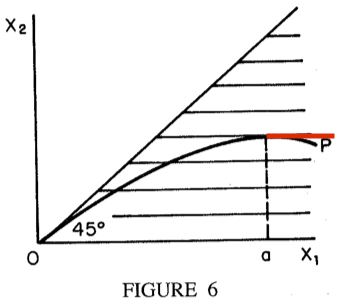Our Discussion
Hutch said that Rawls isn’t hitting the main argument for inheritance straight on. The argument for the legitimacy of inheritance is that parents have rights to give extra educational and financial resources to their children if they want to. It’s not that the children who receive these things from their parents are deserving of them all by themselves. I agree. Rawls may be right in the end, but that’s the argument he has to beat.
Hutch also noted that the difference principle is quite a ways from Locke. Locke thinks you have rights to enough to sustain yourself and to whatever you labor on. Rawls thinks you have a right to at least whatever you get under the difference principle, no matter whether you work or not. If you look at Figure 6, you will notice that there is no reason given why anyone is in the worst off class (X2). Most are probably there because they do not have many skills that are in high demand. But it’s possible to be there simply because you don’t want to work. The difference principle treats everyone in X2 the same, regardless of whether they want to work or not.
This lack of historical information, that is, information about how someone came to be in X2, can be troubling for a different reason. Dylan B. noted that the membership in X2 could be disproportionately made up of the members of a disfavored racial or gender group. I think that Rawls thinks that his principle of equal opportunity will solve this. But I also think that Dylan is right to say that he’s leaving out information that most people think is relevant. The theory is entirely forward looking: it’s about making the worst off group as well off as it can be going into the future. Facts about how people came to be in the worst off group don’t make any difference to the difference principle. That may be a defensible position in the end, but Rawls did not even see the need to defend it. That strikes me as a gap in his theory.
Brandon asked what would happen if the OP line in Figure 6 flattened out to the right of point a rather than curving down. I added a red line to illustrate what he meant.

Roman said that there would be nothing wrong with that. The members of X1 get more without hurting the members of X2. What’s the problem? She was articulating what Rawls calls the principle of efficiency: if you can make some people better off without hurting anyone else, do it! Why leave money on the table, so to speak?
Another way to put it is that Roman was treating those horizontal lines as indifference curves: any distribution on a line is equally good as far as society is concerned. This is perfectly reasonable given the way the graph is drawn. But it’s not actually what Rawls meant.
Rawls himself would have insisted on sticking at point a if the line went flat to the right. The view is not “inequality is OK if it doesn’t harm the welfare of the worst off class.” It is “inequality is OK only if it improves the welfare of the worst off class.” If the line is flat to the right of a the increased wealth going to X1 isn’t improving the standard of living on X2. So it’s not allowed under the difference principle.
That means that those horizontal lines are not actually indifference curves. Rawls thinks society is not indifferent towards any of the points on those lines. He thinks it prefers points closer to the 45 degree line over those that are farther away. The graph is misleading that way. As a personal note, I read it the way Roman did for a long time. And I’m a little miffed about how difficult it is to understand this figure.